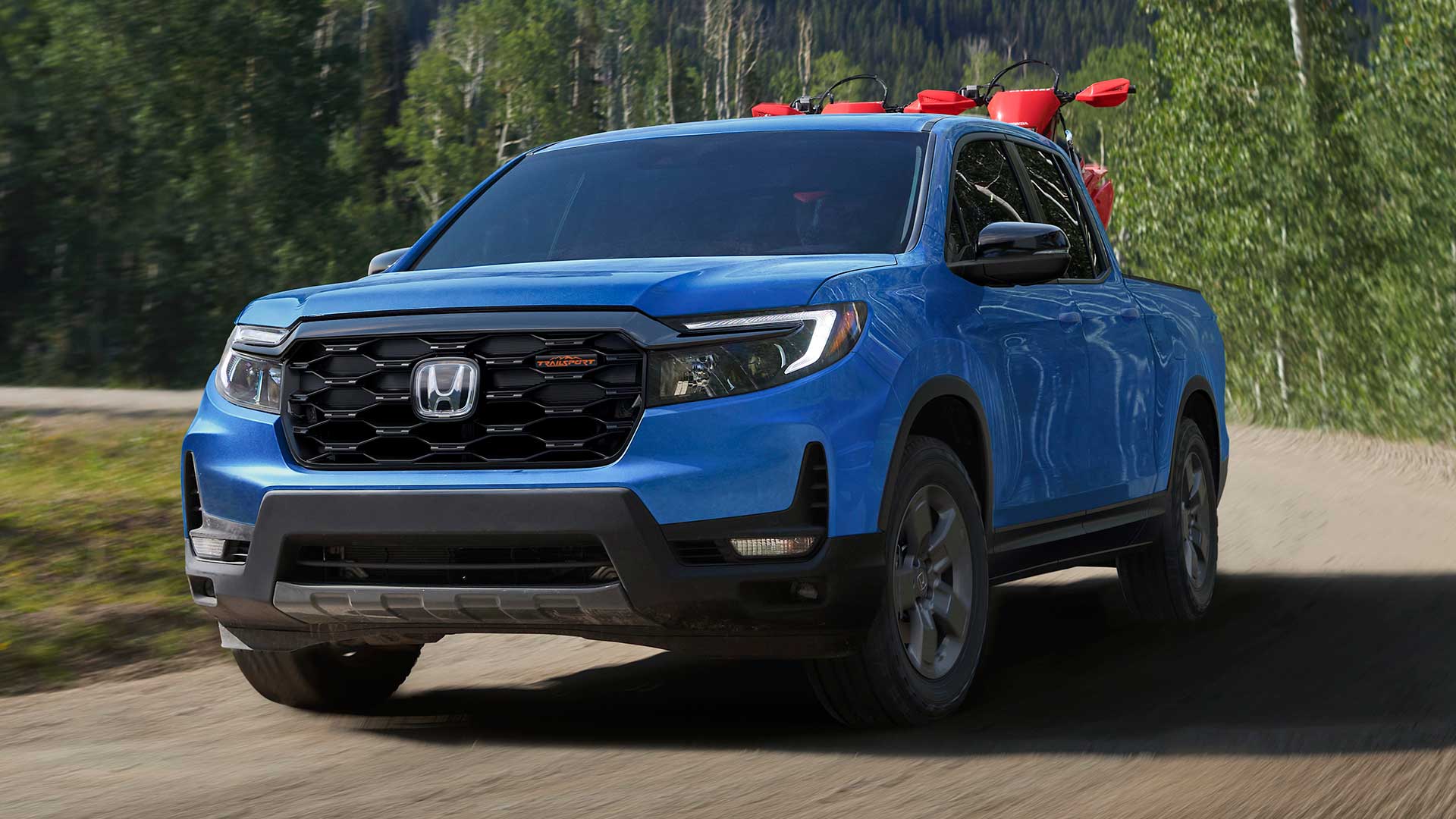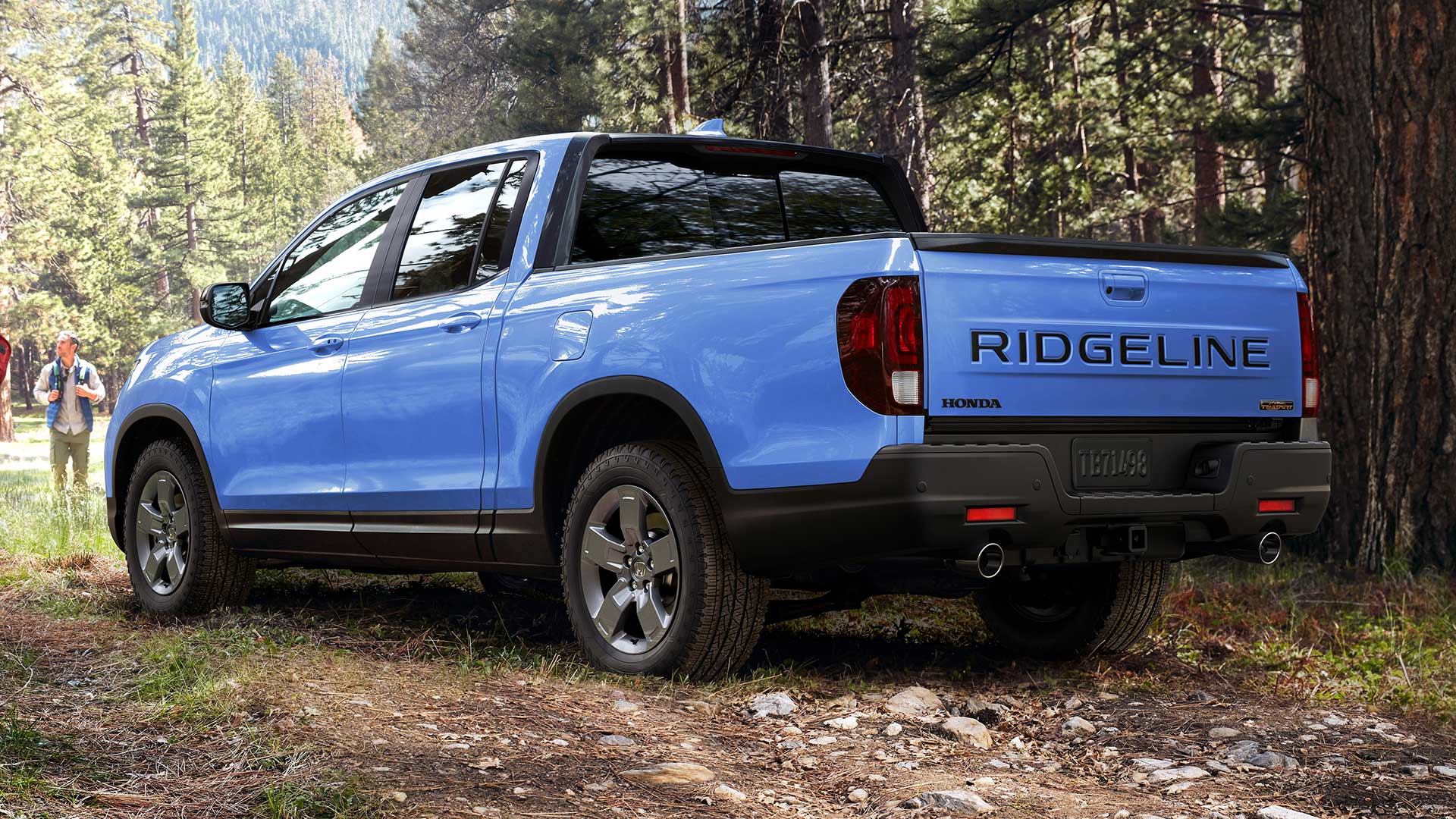2011 Toyota Sienna
When Toyota replaced the oddball Previa with the front-drive Sienna for 1998, it staked a firmer foothold in the minivan market. The redesigned 2004 Sienna added all-wheel-drive as an option, making it a true alternative to popular SUVs. Now, for 2011, the Sienna is all-new again, and it’s crossover utilities that dominate the family scene. So, let’s see if the new Sienna can stand its ground.
The 2011 Toyota Sienna minivan starts off by standing its ground on size. Its 119.3-inch wheelbase is the same as its predecessor. But it is a few fractions of an inch wider and shorter overall, much of which can be attributed to its all-new styling, penned entirely at Toyota’s Calty studio in Newport Beach, California. And, Calty has given Sienna a fairly aggressive version of the corporate notched hood, above a sharply tapered trapezoidal grille. Narrow, dramatically swept-back headlights are set high in a pair of bulging front fenders.
From there, the Sienna’s greenhouse follows the slight curvature of character lines drawn high on its flanks. Unmistakable Venza-like taillights wrap around under the D-pillars.
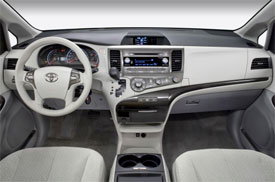 Styling cues vary by trim. The sporty-looking SE’s mesh grille, deep splitter, rocker panels, and smoked taillights set it apart from the rest of the clean but much more pedestrian Sienna lineup. A selection of standard alloy wheels range from 17 to 19 inches in diameter.
Styling cues vary by trim. The sporty-looking SE’s mesh grille, deep splitter, rocker panels, and smoked taillights set it apart from the rest of the clean but much more pedestrian Sienna lineup. A selection of standard alloy wheels range from 17 to 19 inches in diameter.
But while a dose of exterior excitement is fine, the focal point of every minivan is the interior. To that end, the 2011 Sienna fills slightly bigger shoes than last year, with two inches added to interior length. It’s also wider inside, and the now flowing dash has a less pronounced, more integrated center stack to make it feel even roomier.
The front seat passengers are treated to a funky asymmetrical trim swoosh separating two glove boxes, and the driver will find a more upscale instrument cluster with standard ECO driving indicator in the multifunction liquid crystal screen. A full complement of airbags includes one for the driver’s knee.
Standards include tri-zone climate, CD stereo with aux input, up to a dozen cup holders, and dual sliding doors with power windows. Ascend the trim levels, and amenities like wood trim, voice command navigation, and a novel sliding center console are available.
Unlike Chrysler’s minivans, the Sienna’s second row seats don’t fold into the floor. They’re heavy, but are removable. Seven-passenger models have twin captain’s chairs. In Limited trim they recline. The eight-seater features a split bench with a stowable center section. The captain’s chairs have 23 inches of fore/aft travel and seat cushions that tip up, allowing easy access to the third row. There, the 60/40 split bench is placed two inches further back than before for adult-size legroom.
The optional rear entertainment system has a 16.4-inch screen that can display two inputs—like a movie and a game—at the same time. Unlike Chrysler vans, however, satellite TV is not available.
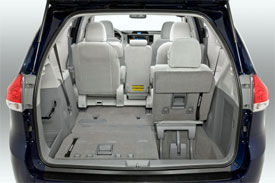 Cargo volume behind the upright third seat is good at 39.1 cubic feet. Drop the third row and cargo volume goes to 87.1 cubic feet. With the second row removed, cargo volume grows to 150 cubic feet, or more than all rivals.
Cargo volume behind the upright third seat is good at 39.1 cubic feet. Drop the third row and cargo volume goes to 87.1 cubic feet. With the second row removed, cargo volume grows to 150 cubic feet, or more than all rivals.
Sienna continues as the only minivan available with all-wheel-drive. For 2011, it returns as an option on V6-powered LE, XLE, and Limited models.
Base power comes from the Sienna's first four cylinder. The 2.7-liter, shared with Highlander and Venza, rates 187 horsepower and 186 pound-feet of torque. The carryover 3.5-liter V6 rates 266 horsepower and 245 pound-feet of torque. A new six-speed transmission with sequential shift handles gear changes for both motors. With the V6, Sienna can tow 3,500 pounds.
Suspension hardware is traditional minivan, strut front and a beam axle rear. But careful retuning, stability control, and new electric power steering provide Sienna an unusually tactile driving experience, especially the SE, which gets treated to an even sportier setup. All-disc ABS brakes are standard.
While the four-cylinder does strain a little under heavy loads, its Government Fuel Economy ratings of 19 city/26 highway are the best in its class. The front drive V6 rates 18 city/24 highway, dropping to 16 city/22 highway with all-wheel-drive. All Siennas run on regular gas.
When it goes on sale later this spring, Sienna prices will start slightly lower than last year at $25,010. The V6 starts at $26,250, and can climb to an eye-popping $40,520 for an all-wheel drive Limited.
That said, the 2011 Toyota Sienna has something for every minivan taste— a more economical four-cylinder, class-exclusive all-wheel drive, and the nicely sporty SE model. So, not only can this highly versatile vehicle stand its ground, it's likely to make a few more suburbanites think twice about buying a big CUV.Specifications
- Engine: 2.7-Liter Four Cylinder
- Horsepower: 187
- Torque: 186 Lb Feet
- EPA: 19 MPG City/ 26 MPG Highway
2024 Honda Ridgeline TrailSport
It Does Truck-Like Things Better Than Ever
Honda brought something truly unique to the pickup truck scene when their mid-size Ridgeline debuted for 2006. In 2017, it moved towards becoming a little more true truck-like, both in form and capability, now with yet another step in that direction for 2024. So, let’s see if the Ridgeline is really hitting its stride.
For 2024, it’s all about making this Honda Ridgeline better than ever. There are styling tweaks outside, along with tech and functional improvements inside, but the biggest news is the Ridgeline has now joined Honda’s TrailSport family of off-road inspired vehicles. This more-true-trucklike, second-gen Ridgeline been around since 2017, receiving periodic updates over the years; but joining the TrailSport family is the biggest leap yet.
Primarily, the TrailSport transformation includes General Grabber all-terrain tires, mounted on new Pewter Gray 18-inch wheels, steel underbody protection, and retuning the strut front, and multi-link rear suspension for added wheel articulation. And while we always appreciate the additional traction of off-road tires, the Ridgeline’s standard i-VTM4 all-wheel drive, with Intelligent Traction Management and snow, sand, and mud settings, was already quite capable of handling all but the most extreme off-roading, ground clearance of just 7.6 inches being it’s only real hinderance.
A 3.5-liter V6 remains under the hood as it has since the Ridgeline debuted for 2006; the current version outputs 280 horsepower and 262 lb-ft of torque, plenty enough muscle to handle its 5,000-lbs. towing capacity. A nine-speed automatic transmission with paddle shifters and bevy of push and pull buttons on the console replaced the six-speed automatic back in 2020.
In addition to adding TrailSport capability, a big focus for this update was making it more user-friendly inside, starting with the central touchscreen growing from 8 to 9 inches. It also gets faster processing speeds, menus have been simplified, and the native navigation system is improved with better graphics. It’s accompanied by a new digital instrument cluster, along with an upgraded center console with more storage space. Unique TrailSport touches include heavy duty floormats, leather-trimmed seats, orange stitching throughout the cabin, and orange ambient lighting.
The Ridgeline continues to offer things available nowhere else in the pickup truck market.
Exterior styling doesn’t exactly shout “macho big rig coming your way,” but the more vertical face and larger grille that arrived for 2021, along with this year’s added TrailSport elements, do continue to toughen up the Ridgeline’s image. The 5’4” bed remains highly functional with no large wheel well intrusions, multiple tie-downs points, lighting and even speakers. And of course, the Ridgeline continues to offer things available nowhere else in the pickup truck market, like the dual-action tailgate, and large, lockable, drainable, underbed storage. Not to mention being able to drive around in true car-like comfort, something we took full advantage of on our way to our Mason Dixon Dragway test track.
There was great grip off the line, with full power arriving smoothly but quickly, helping us to get to 60 in 7.0 seconds flat, a tenth quicker than the last Ridgeline we tested. That power delivery stayed fairly consistent the whole way down the track, barely interrupted by the nine-speed automatic’s smooth shifting. Our best quarter-mile run was 15.5 seconds at 90 mph.
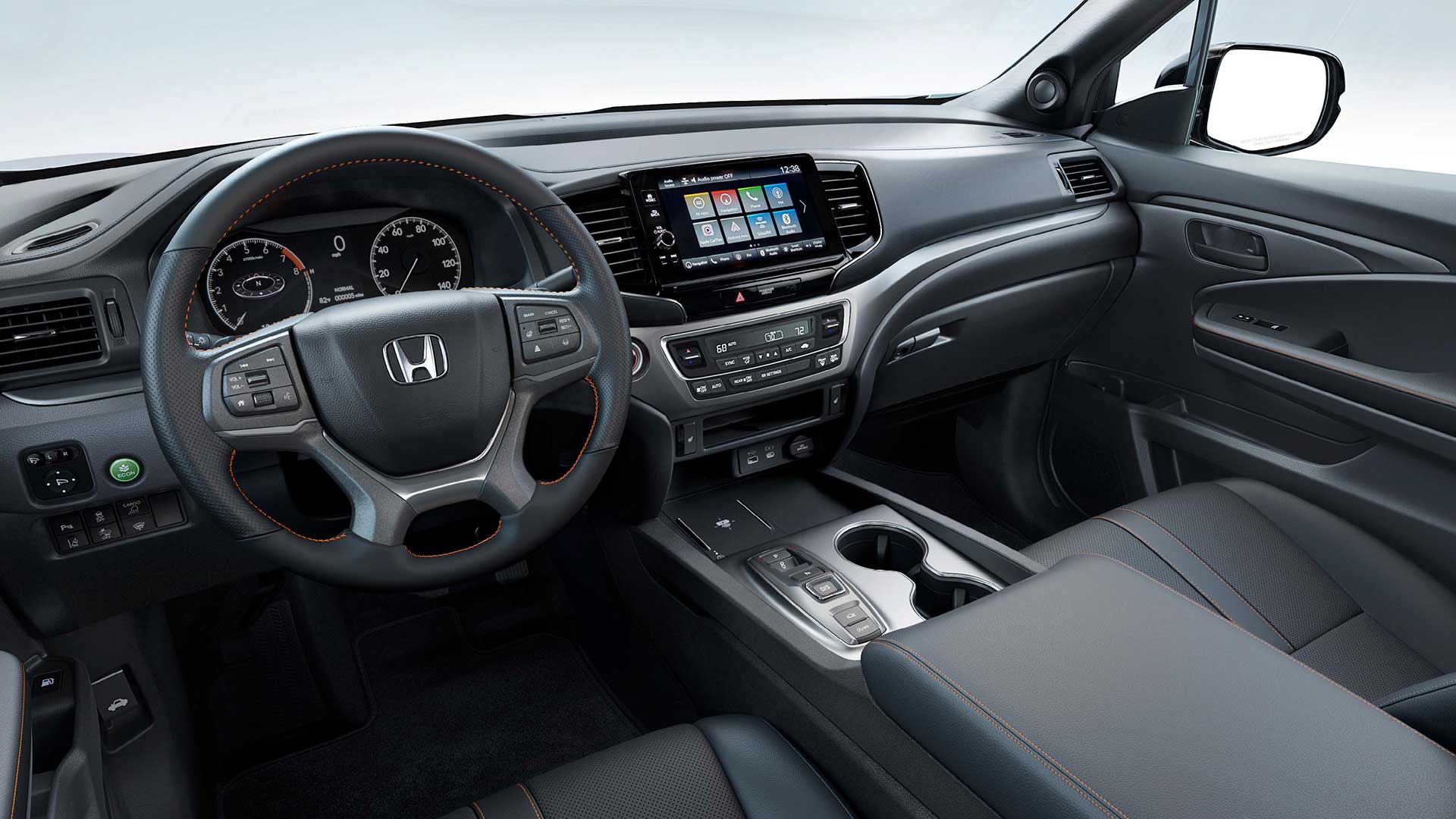
The revised suspension and knobbier tires didn’t really seem to add or detract from handling prowess, as it felt as solid, nimble, and car-like as it always has through our cone course. Perhaps a little less stiff than before, but good feedback, tight steering, and minimal body roll for a pickup, made for a very confidence inspiring experience. In our braking test, we stopped in a respectable average of 123 feet from 60, with only moderate amounts of nosedive and good feel through the pedal.
There is, however, a slight reduction in Government Fuel Economy Ratings with the all-terrain tires; 18-City, 23-Highway, and 20-Combined, our average, right on, at 20.4 mpg of Regular. That’s a slightly below average Energy Impact Score of 14.9 barrels of yearly oil use, with CO2 emissions of 7.4 tons.
TrailSport pricing falls in line just under the Ridgeline’s top Black Edition trim with a starting price of $46,375, about five grand over a base Ridgeline Sport.
So, whether you consider the Honda Ridgeline to be a “real” truck or not, this ruggedly smooth 2024 TrailSport does truck-like things better than ever. And we’re not just talking about the slight upgrade in off-road performance, we’re talking about a flexible bed to help you get chores done, and the ability to tow or haul with comfort and flexibility other trucks can only wish for. It’s why the Ridgeline brings more first-time buyers to Honda than any other vehicle, and why it continues to be a great choice in the growing midsize truck realm.
Specifications
- Engine: 3.5-liter V6
- Transmission: 9-speed automatic
- Horsepower: 280
- Torque: 262 lb-ft
- EPA: 18 City | 23 Highway | 20 Combined
- 0-60 mph: 7.0 seconds
- 1/4 Mile: 15.5 seconds at 90 mph
- 60-0 Braking (avg): 123 feet
- MW Fuel Economy: 20.4 mpg (Regular)
- Max Towing Capacity: 5,000-lbs








